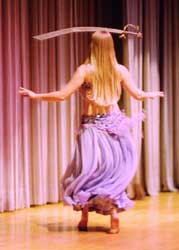The art of belly dancing and Gypsy fusion
Utah State University students may have noticed the many posters advertising a show on Middle Eastern Dance and Gypsy Fusion around campus. The belly dancers arrived.
On April 19, the USU Middle Eastern Dance Club held a workshop and concert featuring Johanna, a professional eastern dancer. The concert also showcased the talents of the club’s dancers and two performing troupes, Shazadi and Zivah.
The dancers had torso and hips whirling, and the isolation of their bodies amazed audience members. Their confidence, synchronism and seduction earned them plenty of catcalls from the mostly-male audience.
The dancers designed and made all of their exquisite costumes, and one performed a solo for two minutes with a sword balanced on her head.
Although the audience members cheered for all of the dancers, when Johanna slinked onto the stage like a sultry Salome, there was no question she was the star of the show.
USUMED has been going since 1977, said Rebecca Habtour, the president of the club. It got its start when Lisa Duskin, who took belly dancing classes in Salt Lake, came to Logan. Enough students expressed interest in belly dancing that they started a club.
“I think [belly dancing] is a fascinating art form,” Habtour said. “When I first saw it, I thought it was a beautiful thing to watch. I discovered it was great exercise, and I made tons of friends. I love it because I get to be creative and feminine.”
She said the club doesn’t advertise much. People who are interested in belly dancing have sought it out, and the club now has about 40 members.
“[Belly dancing] has a healing quality to it,” Habtour said. “It helps build my body confidence and helps a lot of other women feel better about themselves.”
People do not have to have a certain body type to do Middle Eastern dance, she said.
Belly dancing evolved when Middle Eastern countries like Turkey, Egypt and Lebanon started polishing up their local folk dances to entertain tourists from other parts of the Middle East. They began incorporating dances from the tourists’ countries with their own, and things got really mixed up, Habtour said.
It was also at that time that they started wearing two-piece costumes to better show their movements. The veil work Americans are used to is an innovation of the United States. In the Middle East, they use the veil but only as a cape, Habtour said.
“America added something new to this kind of dancing, but that’s OK,” she said. “When each new culture adapts an art form and adds a new part to it, it’s really cool.”
The club members decided to do the concert to get the word out about how wonderful Middle Eastern dance is and to get people to take classes. They also did it to raise money for their primary performing troupe, Shazadi. They will compete nationally at their first competition this summer in Reno, Nev., Habtour said.
For more information on the club, visit its Web Site, www.usu.edu/shimmy.
-erina@cc.usu.edu

Sevda (Jenny Bloomberg) performs a solo number balancing a sword. (Photos by Michael Sharp)

